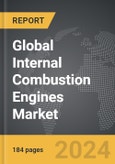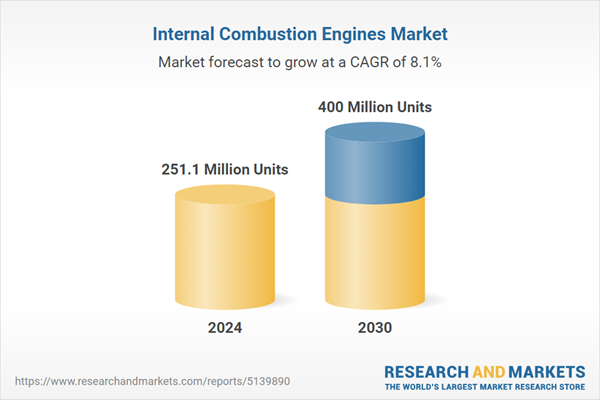The global market for Internal Combustion Engines was sized at 251.1 Million Units in 2024 and is projected to reach 400.0 Million Units by 2030, growing at a CAGR of 8.1% from 2024 to 2030. This comprehensive report provides an in-depth analysis of market trends, drivers, and forecasts, helping you make informed business decisions. The report includes the most recent global tariff developments and how they impact the Internal Combustion Engines market.
Segments: Fuel (Petroleum, Natural Gas); End-Use (Automotive, Aircraft, Marine).
Geographic Regions/Countries: World; United States; Canada; Japan; China; Europe (France; Germany; Italy; United Kingdom; Spain; Russia; and Rest of Europe); Asia-Pacific (Australia; India; South Korea; and Rest of Asia-Pacific); Latin America (Argentina; Brazil; Mexico; and Rest of Latin America); Middle East (Iran; Israel; Saudi Arabia; United Arab Emirates; and Rest of Middle East); and Africa.
The analysts continuously track trade developments worldwide, drawing insights from leading global economists and over 200 industry and policy institutions, including think tanks, trade organizations, and national economic advisory bodies. This intelligence is integrated into forecasting models to provide timely, data-driven analysis of emerging risks and opportunities.
Global Internal Combustion Engines Market - Key Trends & Drivers Summarized
What Are Internal Combustion Engines and Why Do They Continue to Dominate the Automotive Industry?
Internal combustion engines (ICEs) are engines that generate power through the combustion of fuel, typically gasoline or diesel, within a confined space, producing mechanical energy that drives vehicles and machinery. Despite the growing push towards electric vehicles (EVs), ICEs continue to dominate the automotive industry due to their established technology, extensive fueling infrastructure, and ability to deliver high performance and range. ICEs are widely used not only in passenger cars but also in commercial vehicles, heavy machinery, and marine and aerospace applications. Their ability to provide reliable and efficient power across a wide range of conditions has kept them at the forefront of global transportation, even as the industry begins to shift towards more sustainable energy sources.How Are Technological Advancements Shaping the Internal Combustion Engines Market?
Technological advancements are significantly shaping the internal combustion engines market, particularly through innovations aimed at improving efficiency, reducing emissions, and enhancing performance. The development of turbocharging and direct fuel injection technologies has increased the power output of smaller engines, enabling them to deliver performance levels previously achievable only by larger engines. Advances in engine management systems, including variable valve timing and start-stop systems, are improving fuel efficiency and reducing emissions by optimizing engine operation based on real-time driving conditions. Additionally, the integration of hybrid technologies, where ICEs work in tandem with electric motors, is extending the relevance of internal combustion engines in the era of electrification. These technological innovations are helping ICEs remain competitive as regulatory pressures and consumer preferences push the automotive industry towards more environmentally friendly solutions.Why Is There an Ongoing Demand for Internal Combustion Engines Across Various Sectors?
The demand for internal combustion engines continues across various sectors due to their versatility, reliability, and well-established infrastructure. In the automotive sector, ICEs remain the preferred choice for many consumers, particularly in regions where electric vehicle adoption is slower due to factors such as charging infrastructure limitations and higher upfront costs. The commercial vehicle segment, including trucks and buses, heavily relies on ICEs for long-haul transportation and heavy-duty operations, where the current capabilities of electric powertrains are still developing. In industrial applications, such as construction, mining, and agriculture, ICEs are essential for powering machinery that operates in remote locations where electrification is not yet feasible. The marine and aerospace industries also depend on ICEs for propulsion, particularly in vessels and aircraft that require high power output and reliability. As these sectors continue to rely on ICE technology, the market for internal combustion engines remains robust, even as the industry begins to transition towards alternative power sources.What Factors Are Driving the Growth in the Internal Combustion Engines Market?
The growth in the internal combustion engines market is driven by several factors related to technological advancements, market demand, and the evolving landscape of global transportation. One of the primary drivers is the ongoing need for high-performance engines that offer a balance of power, efficiency, and range, particularly in commercial and heavy-duty applications where electric alternatives are still emerging. The continuous improvement of ICE technology, aimed at reducing emissions and increasing fuel efficiency, is also propelling market growth, allowing these engines to meet increasingly stringent environmental regulations. The global expansion of transportation networks, particularly in emerging markets, is creating new demand for vehicles and machinery powered by ICEs, further supporting the market. Additionally, the development of hybrid powertrains, which combine the strengths of ICEs and electric motors, is extending the relevance of internal combustion engines in the transition towards electrification. As these factors continue to influence the industry, the internal combustion engines market is expected to experience steady growth, driven by the ongoing demand for versatile, reliable, and high-performance power solutions.Report Scope
The report analyzes the Internal Combustion Engines market, presented in terms of units. The analysis covers the key segments and geographic regions outlined below.Segments: Fuel (Petroleum, Natural Gas); End-Use (Automotive, Aircraft, Marine).
Geographic Regions/Countries: World; United States; Canada; Japan; China; Europe (France; Germany; Italy; United Kingdom; Spain; Russia; and Rest of Europe); Asia-Pacific (Australia; India; South Korea; and Rest of Asia-Pacific); Latin America (Argentina; Brazil; Mexico; and Rest of Latin America); Middle East (Iran; Israel; Saudi Arabia; United Arab Emirates; and Rest of Middle East); and Africa.
Key Insights:
- Market Growth: Understand the significant growth trajectory of the Petroleum segment, which is expected to reach 314.5 Million Units by 2030 with a CAGR of a 8.0%. The Natural Gas segment is also set to grow at 8.3% CAGR over the analysis period.
- Regional Analysis: Gain insights into the U.S. market, sized at 64.7 Million Units in 2024, and China, forecasted to grow at an impressive 11.7% CAGR to reach 99.2 Million Units by 2030. Discover growth trends in other key regions, including Japan, Canada, Germany, and the Asia-Pacific.
Why You Should Buy This Report:
- Detailed Market Analysis: Access a thorough analysis of the Global Internal Combustion Engines Market, covering all major geographic regions and market segments.
- Competitive Insights: Get an overview of the competitive landscape, including the market presence of major players across different geographies.
- Future Trends and Drivers: Understand the key trends and drivers shaping the future of the Global Internal Combustion Engines Market.
- Actionable Insights: Benefit from actionable insights that can help you identify new revenue opportunities and make strategic business decisions.
Key Questions Answered:
- How is the Global Internal Combustion Engines Market expected to evolve by 2030?
- What are the main drivers and restraints affecting the market?
- Which market segments will grow the most over the forecast period?
- How will market shares for different regions and segments change by 2030?
- Who are the leading players in the market, and what are their prospects?
Report Features:
- Comprehensive Market Data: Independent analysis of annual sales and market forecasts in US$ Million from 2024 to 2030.
- In-Depth Regional Analysis: Detailed insights into key markets, including the U.S., China, Japan, Canada, Europe, Asia-Pacific, Latin America, Middle East, and Africa.
- Company Profiles: Coverage of players such as Andreas Stihl AG & Co. KG, Ashok Leyland Ltd., BMW AG, Bombardier, Inc., Briggs & Stratton Corporation and more.
- Complimentary Updates: Receive free report updates for one year to keep you informed of the latest market developments.
Some of the 22 companies featured in this Internal Combustion Engines market report include:
- Andreas Stihl AG & Co. KG
- Ashok Leyland Ltd.
- BMW AG
- Bombardier, Inc.
- Briggs & Stratton Corporation
- Caterpillar, Inc.
- CNH Industrial N.V.
- Cummins, Inc.
- Daimler AG
- Detroit Diesel Corporation
- Deutz AG
- Doosan Infracore Co., Ltd.
- Eicher Motors Ltd.
- FCA US LLC
- Ford Motor Company
- GE Power
- Greaves Cotton Limited
- Hino Motors Ltd.
- Honda Motor Co., Ltd.
- Husqvarna AB
- Isuzu Motors Ltd.
- JCB India Ltd.
- John Deere
- Kawasaki Heavy Industries Ltd.
- Kirloskar Oil Engines Ltd.
- Kohler Company
- Komatsu Ltd.
- Kubota (UK) Ltd.
- Liebherr-International AG (Liebherr Group)
- Lombardini Srl.
- Lycoming Engines
- MAN SE
- Mercedes-Benz
- Mitsubishi Turbocharger and Engine Europe B.V.
- Moteurs Baudouin
- Mtu Friedrichshafen GmbH
- Navistar, Inc.
- Paccar Inc.
- Perkins Engines Company Limited
- Rolls-Royce Holdings PLC
- Scania AB
- STEYR MOTORS GmbH
- Suzuki Corporation
- Toyota Motor Corporation
- Volkswagen AG
- Volvo Penta
- Wacker Neuson SE
- Wartsila Corporation
- Weichai Power Co., Ltd.
- Yamaha Corporation
- Yanmar Co., Ltd.
- Zetor Tractors AS
Tariff Impact Analysis: Key Insights for 2025
Global tariff negotiations across 180+ countries are reshaping supply chains, costs, and competitiveness. This report reflects the latest developments as of April 2025 and incorporates forward-looking insights into the market outlook.The analysts continuously track trade developments worldwide, drawing insights from leading global economists and over 200 industry and policy institutions, including think tanks, trade organizations, and national economic advisory bodies. This intelligence is integrated into forecasting models to provide timely, data-driven analysis of emerging risks and opportunities.
What’s Included in This Edition:
- Tariff-adjusted market forecasts by region and segment
- Analysis of cost and supply chain implications by sourcing and trade exposure
- Strategic insights into geographic shifts
Buyers receive a free July 2025 update with:
- Finalized tariff impacts and new trade agreement effects
- Updated projections reflecting global sourcing and cost shifts
- Expanded country-specific coverage across the industry
Table of Contents
I. METHODOLOGYII. EXECUTIVE SUMMARY2. FOCUS ON SELECT PLAYERSIII. MARKET ANALYSISSOUTH KOREAREST OF ASIA-PACIFICARGENTINABRAZILMEXICOREST OF LATIN AMERICAIRANISRAELSAUDI ARABIAUNITED ARAB EMIRATESREST OF MIDDLE EASTIV. COMPETITION
1. MARKET OVERVIEW
3. MARKET TRENDS & DRIVERS
4. GLOBAL MARKET PERSPECTIVE
UNITED STATES
CANADA
JAPAN
CHINA
EUROPE
FRANCE
GERMANY
ITALY
UNITED KINGDOM
SPAIN
RUSSIA
REST OF EUROPE
ASIA-PACIFIC
AUSTRALIA
INDIA
LATIN AMERICA
MIDDLE EAST
AFRICA
Companies Mentioned (Partial List)
A selection of companies mentioned in this report includes, but is not limited to:
- Andreas Stihl AG & Co. KG
- Ashok Leyland Ltd.
- BMW AG
- Bombardier, Inc.
- Briggs & Stratton Corporation
- Caterpillar, Inc.
- CNH Industrial N.V.
- Cummins, Inc.
- Daimler AG
- Detroit Diesel Corporation
- Deutz AG
- Doosan Infracore Co., Ltd.
- Eicher Motors Ltd.
- FCA US LLC
- Ford Motor Company
- GE Power
- Greaves Cotton Limited
- Hino Motors Ltd.
- Honda Motor Co., Ltd.
- Husqvarna AB
- Isuzu Motors Ltd.
- JCB India Ltd.
- John Deere
- Kawasaki Heavy Industries Ltd.
- Kirloskar Oil Engines Ltd.
- Kohler Company
- Komatsu Ltd.
- Kubota (UK) Ltd.
- Liebherr-International AG (Liebherr Group)
- Lombardini Srl.
- Lycoming Engines
- MAN SE
- Mercedes-Benz
- Mitsubishi Turbocharger and Engine Europe B.V.
- Moteurs Baudouin
- Mtu Friedrichshafen GmbH
- Navistar, Inc.
- Paccar Inc.
- Perkins Engines Company Limited
- Rolls-Royce Holdings PLC
- Scania AB
- STEYR MOTORS GmbH
- Suzuki Corporation
- Toyota Motor Corporation
- Volkswagen AG
- Volvo Penta
- Wacker Neuson SE
- Wartsila Corporation
- Weichai Power Co., Ltd.
- Yamaha Corporation
- Yanmar Co., Ltd.
- Zetor Tractors AS
Table Information
| Report Attribute | Details |
|---|---|
| No. of Pages | 184 |
| Published | April 2025 |
| Forecast Period | 2024 - 2030 |
| Estimated Market Value in 2024 | 251.1 Million Units |
| Forecasted Market Value by 2030 | 400 Million Units |
| Compound Annual Growth Rate | 8.1% |
| Regions Covered | Global |









